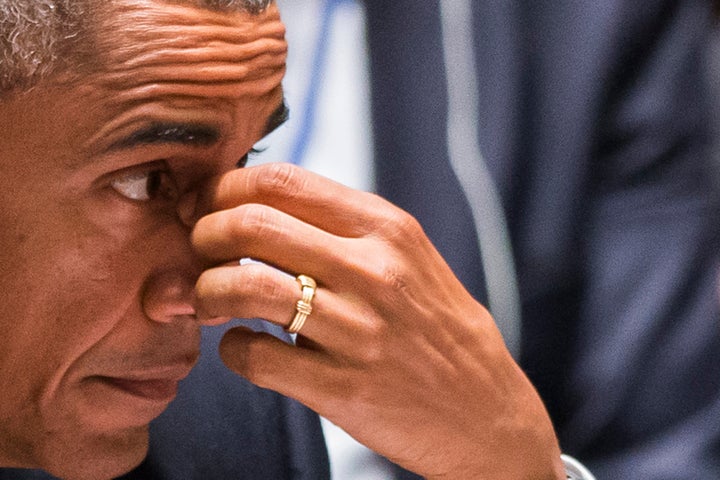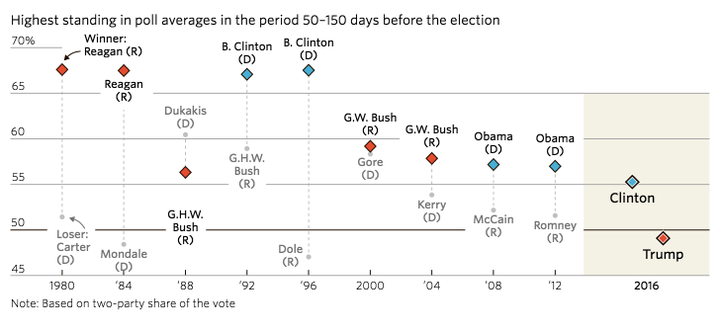
Donald Trump has convinced most Republicans to vote for him, but he still can’t persuade them that President Obama was born in the U.S. And The New York Times Upshot demonstrates how much pollsters’ choices matter. This is HuffPollster for Wednesday, September 21, 2016.
DONALD TRUMP’S CHANGE OF HEART ON BIRTHERISM DIDN’T CONVINCE MOST REPUBLICANS - HuffPollster: “Donald Trump, one of the loudest proponents of the conspiracy theory that President Barack Obama wasn’t born in the U.S., publicly abandoned the idea last week…. In the wake of Trump’s statement, Republicans are now less likely than they were in January to say Obama was not born in America, but a substantial majority still refuse to say affirmatively that he was, a new HuffPost/YouGov poll finds…. In order to test the effects of Trump’s statement on public opinion about Obama’s birthplace, the HuffPost/YouGov poll divided survey respondents into two groups and asked each group slightly different questions. Half were simply asked, ‘Do you think Barack Obama was born in the United States, or not?’ The other half were first told about Trump’s statement that Obama was American-born. About the same percentage of Republicans in both groups said they believed Obama was born in America ― 32 percent of those who didn’t see Trump’s quote, and 34 percent who did, staked out that position. But while 46 percent of those who weren’t prompted with Trump’s quote said that Obama was not born in America, 33 percent of those who were told about his quote still felt that way. Respondents presented with Trump’s statement were more likely to hedge by saying that they weren’t sure whether Obama was born in the U.S. or not.” [HuffPost]
GOP VOTERS HAVE MOSTLY UNIFIED BEHIND TRUMP - Janie Velencia: “Republican support for Donald Trump is at an all-time high, with GOP voters now just as unified behind Trump as Democrats are behind Hillary Clinton, according to the HuffPost Pollster polling average. Polls have shown a tightening race in recent weeks, leaving Democrats on edge and concerned that Clinton is losing the comfortable lead she held over the summer…. Clinton has typically enjoyed an advantage against Trump in the polls, partly because she pulled a greater portion of her party’s vote than Trump did. And her support among Democrats has been relatively stable throughout the general election. But the former reality TV star has finally caught up to her. Trump is now pulling 83 percent of the Republican vote, the same level of support that Clinton has among Democrats.” [HuffPost]
HOW FOUR POLLSTERS CAME UP WITH DIFFERENT RESULTS FROM THE SAME DATA- Nate Cohn: “Polling results rely as much on the judgments of pollsters as on the science of survey methodology. Two good pollsters, both looking at the same underlying data, could come up with two very different results. How so? Because pollsters make a series of decisions when designing their survey, from determining likely voters to adjusting their respondents to match the demographics of the electorate.... To illustrate this, we decided to conduct a little experiment. On Monday, in partnership with Siena College, the Upshot published a poll of 867 likely Florida voters. Our poll showed Hillary Clinton leading Donald J. Trump by one percentage point. We decided to share our raw data with four well-respected pollsters and asked them to estimate the result of the poll themselves…. The pollsters made different decisions in adjusting the sample and identifying likely voters. The result was four different electorates, and four different results.” [NYT]
Another example: How the NBC/SurveyMonkey team does looks at likely voters. [NBC]
What’s the best way to explain this kind of survey error?- HuffPollster: “This is an important lesson in non-sampling sources of error: The choices an analyst makes about how to define likely voters can substantially affect the outcome of the poll. But Cohn takes the lesson a step further and argues that the existence of these other sources of error mean margin of error wasn’t worth reporting in the original poll…. The question, then, is how best to explain survey error. Cohn chose to mention it, but not give it an exact figure in the poll release story: ‘All polls, of course, are subject to a margin of error. But the margin of error does not include many other potential sources of error, like the choices of the many undecided voters, or decisions made by pollsters about how to adjust the poll.’ This is a good start. However, that still leaves readers to wonder just how much error there is in the poll…. Most non-experts probably don’t have the answer to that question.... We should be able to address error better in the polling field.” [HuffPost]
DONALD TRUMP’S CEILING OF SUPPORT REMAINS UNUSUALLY LOW - Randy Yeip: “One of the enduring truths of the 2016 presidential campaign has been the seeming inability of Donald Trump and Hillary Clinton to break through their low ceilings of support. Mr. Trump has struggled to break out of the low 40s. This ceiling appears to be lower than any other nominee of either major party in recent years. Consider all national polls conducted since June 1, more than 100 of them. Nine out of 10 have Mr. Trump below 44%. This includes questions testing one-on-one matchups as well as those that include third-party candidates….All previous winners have demonstrated at least the potential to win the backing of a majority of voters, even if their eventual vote share was much lower. That Mr. Trump has topped out in the high 40s so far is a troubling sign for the Republican’s prospects and puts him about even with failed presidential candidates Walter Mondale and Bob Dole.” [WSJ]

HUFFPOLLSTER VIA EMAIL! - You can receive this daily update every weekday morning via email! Just click here, enter your email address, and click “sign up.” That’s all there is to it (and you can unsubscribe anytime).
WEDNESDAY’S ‘OUTLIERS’ - Links to the best of news at the intersection of polling, politics and political data:
-Monmouth University gives Hillary Clinton a 5-point lead in Florida, where the HuffPost average puts her up by 2. [Monmouth, Florida chart]
-Sasha Issenberg and Steven Yaccino game out the effect of early voting in Iowa, Nevada and North Carolina. [Bloomberg]
-Chris Cillizza looks at the Clinton team’s possible paths to victory. [WashPost]
-Julia Azari examines how terrorist attacks have affected the presidential race so far. [538]
-Mark Blumenthal explains why the candidates’ biggest challenge at the debates might be how they’re perceived. [SurveyMonkey]
-Gallup reviews data on civic engagement worldwide. [Gallup]